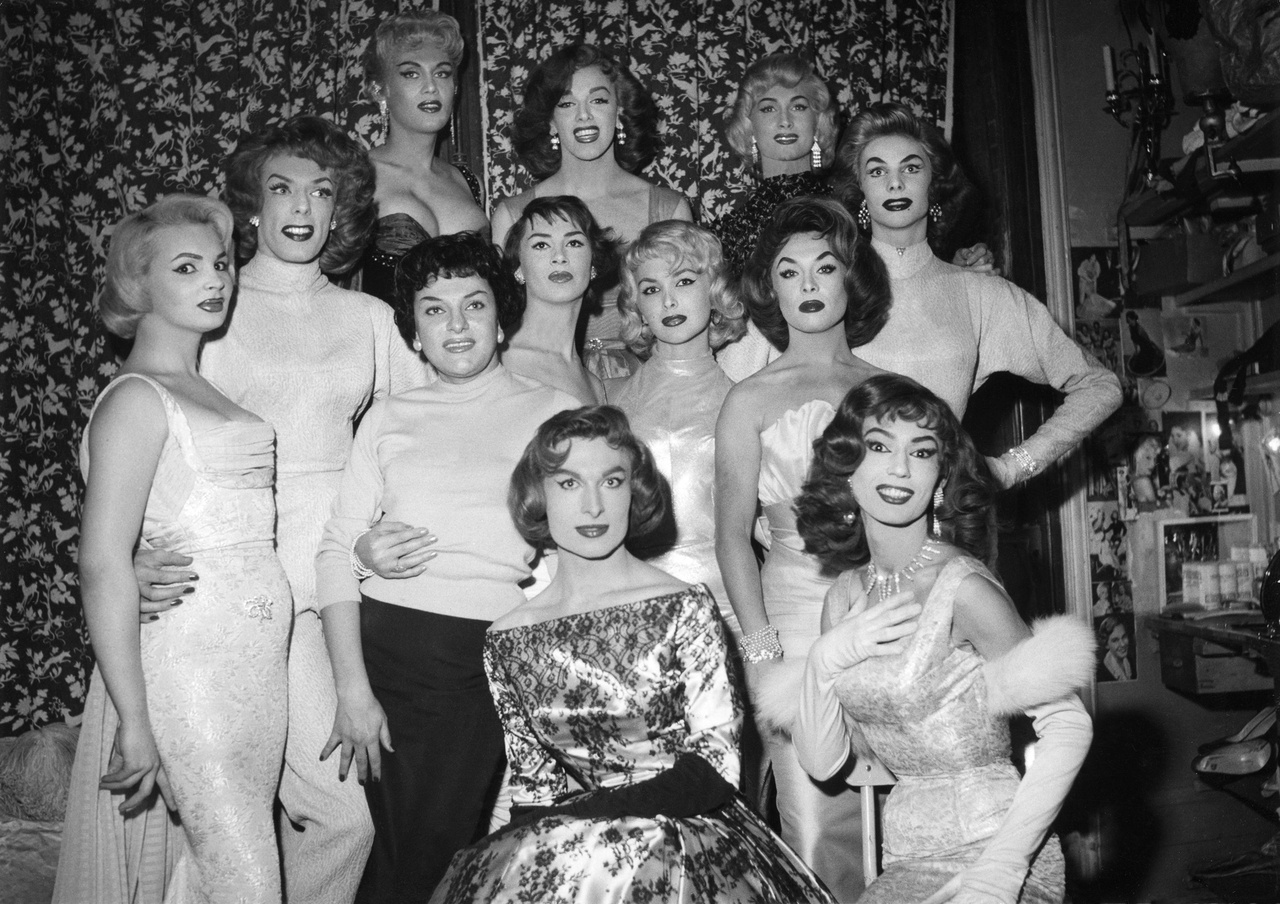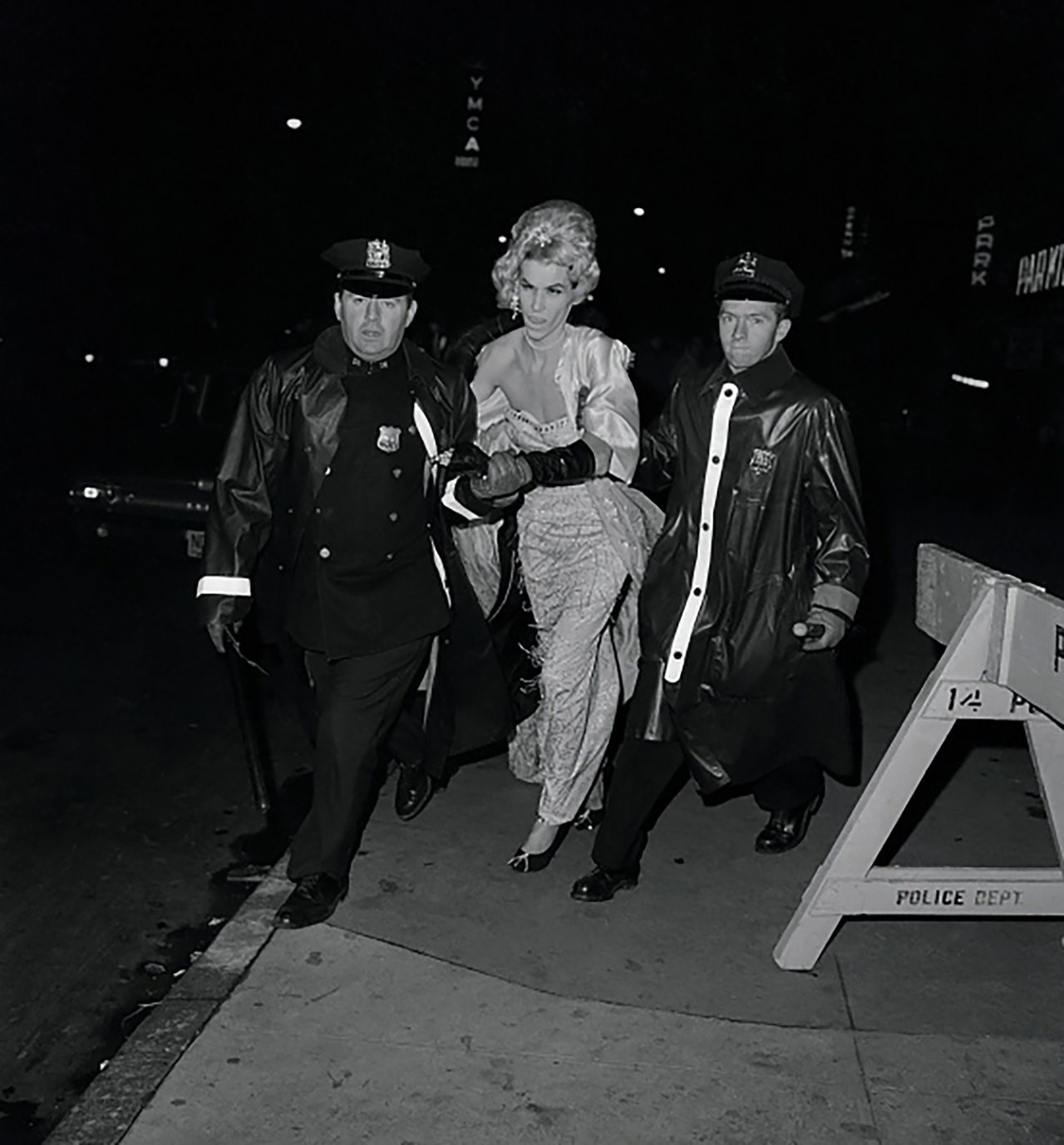BEYOND REPRESENTATIONAL JUSTICE

Bambi and the / und die Cross-Dresser’s Band, The Carrousel, Paris, 1958
What is representational justice? [1] One example can be found in the exhibition “Under Cover: A Secret History of Cross-Dressers” at C|O Berlin. The impressive collection, assembled by Sébastien Lifshitz over decades of detailed work, consists largely of postcards and snapshots of gender-nonconforming people. The collection is a treasure trove for historical research. [2] Yet the exhibition, curated by Lifshitz and Kathrin Schönegg, turns it into a school of clocking. We encounter a typology of gender-nonconforming people, with a particular focus on trans femininity centering around Marie-Pierre Pruvot (known as Bambi), who performed as a burlesque artist in France from the 1950s to the 1970s, then studied, transitioned, and later worked as an elementary school teacher in a Paris suburb. Besides her central role in the exhibition, we find a nearly 90-minute documentary of her life. Her story is surely worth telling. However, I want to focus on something else: the exhibition turns visitors into criminal investigators. Picture by picture, our gaze is trained to spot the more or less subtle clues indicating what sex had been assigned at birth to the person depicted. The exhibition seems oblivious to the real-world consequences of visibility. And here we have our prime example: Representational justice treats representation as a means of equality. Yet it ignores that the problem is not the (lack of or incorrect) representation itself but the violence it perpetrates.
For on the one hand, trans people benefit from media representation, insofar as it presents trans identity as a viable alternative. Furthermore, such representation also engenders a social discourse that can serve as a basis for legal changes. Visibility does, however, have a toxic component as well. [3] Some trans people – and for many years this also included Pruvot – simply prefer not to be recognized as trans. [4] Another factor is safety:
After the visibility of trans people of color increased in the United States in 2014, the violence seemed to worsen dramatically. The number of murders of trans people grew in 2015 by 50 percent. […] [T]ransgender women and people of color [are still] experiencing the highest rate of violence. […] The continued increase in murders of trans women of color underscores the deep need for political strategies other than simple visibility or invisibility […]. [5]

Bambi at the age of / im Alter von 39 years / Jahren, 1974
But is subversive visibility not a credo of queer theory? Judith Butler famously argues in Gender Trouble that gender is constantly constructed via the performative re-iteration of gender norms. [6] Consequentially, these norms can be gradually subverted by repeatedly enacting in alternative, dissenting ways. A larger spectrum of differently gendered people can then be accommodated in the spaces thus created. These emancipatory effects of visibility are the theoretical foundation of representational justice. However, this picture is only partially true. After all, the erosion of norms is only emancipatory where oppression is carried out through the violent enforcement of prescriptive norms. [7]
But what happens when transgression itself becomes a mechanism of control? If we differentiate disciplinary societies from neoliberal societies, we notice two fundamentally different modes of normativity: [8] Disciplinary societies enforce obedience by violence; deviance is pathologized, punished, threatened, beaten, excluded, murdered. In neoliberal societies, transgression generates surplus value. Here, deviance is made marketable for consumption and production. Transness is currently situated on the threshold between normative disciple and neoliberal control – that is, between pathologization, criminalization, and disciplinary violence, on the one hand, and the diversification of consumption and production, on the other. What’s next? This is currently the subject of intense struggle.
Back in 2015, for example, Google Business took advantage of Jacob Wanderling’s transition to advertise the company’s search function: “When people are looking online for a different kind of gym, somewhere that’s safe and inclusive, I want them to find us.” [9] Deviance is in great demand as a creative impulse. After all, alternative perspectives offer an ideal resource for the perpetual renewal of neoliberal mechanisms of production. [10] Consequentially, trans people have made significant contributions in all sorts of disciplines and are increasingly being rewarded for it. [11] And yet, euphoria and fear toward trans people can and do coexist. [12]
From all sides, trans people are being deployed against the specter of disciplinary society: while hostility toward trans people has served as a unifying element of right-wing authoritarian politics in its struggle against an allegedly authoritarian “gender ideology,” so-called progressive forces are forming in opposition to what they see as an oppressive and restrictive array of norms, stereotypes, and prejudices. [13] Yet progressive tolerance is kept in narrow confines: trans people will be granted protection and recognition only insofar as they participate in neoliberal regimes of exploitation as market-virile, tax-paying, and otherwise law-abiding individuals. Visibility and subversion have thus become objects of ideological exploitation in the face of neoliberalized mechanisms of social control. This counts for both the politics of power and the politics of exploitation, and with limited agency for (at least white, bourgeois, market-oriented) trans subjects. Here pinkwashing, there conservative values – but always in opposition to the specter of a disciplinary society.
It is only in this context of resistance to allegedly disciplinary forces that visibility and subversion make any sense as a means of emancipation from norms. But visibility and subversion also generate problems apart from ideological exploitation:
(1) Indeterminacy
Although the systematic transgression of norms can help to transform them, it can also lead to their intensification: when I was recently threatened with death at a Halloween party, I was not perceived as an epitome of queer subversion. In fact, my transgression became an occasion to perform cis patriarchal hetero masculinity in an entirely unironic way. Nothing can guarantee the subversive effect of transness. The same can be said about the exhibition of the Lifshitz collection at C|O: nothing prevents hegemonically identified visitors from reading it as a freak show, from reaffirming their own gender identity one photo at a time, or from drawing on this typology of transgressions to identify trans people outside the exhibition space, where they become subject to other people’s projections and insecurities. Subversion without re-subjectification runs the risk of remaining mere re-inscription. The goal of subversion cannot be mere representation. Every audience must be addressed in a particular way. The standard mode of subjectification in a photo exhibition like “Under Cover” is still that of the disembodied arbiter deciding between good and bad, interesting and uninteresting, beautiful and boring, affecting and depressing, et cetera. [14]
This is the cis-white patriarchal subjectivity the exhibition space and its cultural history are inscribed with and, indeed, modeled on. Therefore, subversion cannot simply mean to confront patriarchal subjects with some imagery and hope for the best. Subversion must actively render cis white patriarchal subjectification impossible while also creating alternative spaces. Therefore, subversion is more a question of curation and less of representation.

„Under Cover: A Secret History of Cross-Dressers“, C|O Berlin, 2022/23, installtion view / Ausstellungsansicht
(2) Exhaustion and normalization
The idea of performative subversion can lead one to (implicitly) conceive of transness as a momentary transgression or as the horizon of an emancipation process of society at large – cis gender is then tacitly normalized as the unexamined opposite of transgression. Yet, some of us have to live in the metaphors that others decorate their theories and artworks with. Representational justice, the politics of visibility, and subversion as a political strategy are fashionable instruments for academic analysis. They are neat concepts if we want to stage ourselves as revolutionary subjects in left-wing political peer groups. Yet they are tough to live in. What are the effects when socially sanctioned aggression, constant distance in everyday interactions, repeated refusal of solidarity and privileging toward cis gender drag on for years? Is it not exhaustion and mistrust? The revolution has been overdue for a long time, and our allies do not – or barely – have to carry its burden. The existence of viable trans identities is being left out of the equation. Why? Who is afraid of irreversible transitions and surgical intervention – if not those who (implicitly) normalize cis bodies and cis identities as intrinsically worthy of protection? Is this not ultimately the reinscription of biological gender at the level of political reality?
(3) Exploitation
In neoliberal societies, the transgression of norms itself becomes a source of exploitation. David Getsy’s “axioms” for trans studies in art history can serve as an exemplary case: “Take as axiomatic that seeing someone’s body – even in a state of exposure and scrutiny – does not tell us who they are or what gender they know themselves to be.” [15] But why undergo facial feminization surgery if not for the sake of social intelligibility? [16] If white cis men can declare in the name of trans studies that trans women should not be read as women, nothing is won. Getsy, of course, can capitalize on the growing interest in trans by giving cis artists the consecrations of political correctness. Yet neither he nor his subjects must suffer the consequences of the lauded transgression of gender norms themselves. [17] The bottom line is: trans people are being exploited. Getsy has been making his academic career on the backs of those who live in his theories – and, in the worst case, he even stands in their way.
Representational justice forgets that the problem is not representation itself but the violence that emanates from it. Representational justice is merely nominal, not material emancipation. In relation to race, Charles Mills describes a state of nominal recognition accompanied by the denial of the material consequences of racism:
Whereas before it was denied that nonwhites were equal persons, it is now pretended that nonwhites are equal abstract persons who can be fully included in the polity merely by extending the scope of the moral operator [access to rights], without any fundamental change in the arrangements that have resulted from the previous system of explicit de jure racial privilege [such as the distribution of wealth]. [18]

Police raid at the / Razzia beim National Variety Artists Exotic Carnival and Ball in Manhattan, 1962
In disciplinary societies, minoritized people are denied the status of legal subjects. They are subjected to violence, ignorance, and social isolation. Neoliberal societies, on the other hand, recognize minoritized people as legal subjects. The minoritized now have the right to be exploited without risking their lives – just like everyone else. That being said, the existing material order is, among other things, a result of the disciplinary imposition of cis gender norms. What about the effects of past historical injustice? What happens to fortunes that were amassed through theft, expropriation, and murder? And what happens to the careers of trans people that have been ruined, to social networks that partly generate their binding power from transphobic stereotypes (male alliances, fraternities, patriarchal female socialization)? What happens to artistic canonization, to ideals of beauty, to pictorial traditions and archives that were established over centuries? Here, the violence lives on – day by day.
Yet museums are full of works by cis artists. Sell them! Generate a new canon! Devalue cis gender aesthetically! Let trans people write about your art! Turn over your galleries, your studios, your art collections to trans collectives! [19] Provide trans people with money, housing, resources, et cetera! These would be adequate measures to respond to how, historically, trans identities, careers, and the representation of trans people have been rendered impossible. Shocked? Provoked? Representational justice belies the magnitude of the injustice and obfuscates the radical nature of the steps that would be needed to rectify it. [20] It distorts the problem into a minority issue.
But the murder, exploitation, and disciplining of all minorities always means the establishment of a hegemonic order. People are not born cis – they are made so. And how are they made so? Through transphobia – and especially through transmisogyny. By encouraging cis male behavior while discouraging non-male behavior – that is, trans femininity. There is no patriarchy without transmisogyny. Thus, to be cis means to benefit from hostility toward trans people. Yet relief and repair in this context mean more than just a few jobs for a few trans people, a special issue and some trans perspectives once in a while, occasionally featuring some trans people on the cover of a magazine, or sharing their posts on social media. [21] Trans politics must mean the fundamental transformation of all social conditions.
Trans people have been systematically murdered, intimidated, and kept in poverty. [22] Trans politics is not just the politics of legal equality. It is also the politics of improving the material living conditions of all people through eradicating exploitation and violence against trans people. Therefore, successful trans politics must ultimately lead to the end of cis white hetero patriarchy. Trans politics is thus also the expropriation of large housing companies, because the vast majority of trans people pay rent. Trans politics is also the decriminalization of sex work, because many trans people do sex work. Trans politics is also about collective bargaining as well as curbing inflation and the rising cost of living, because trans people are more likely to be affected by poverty and thus proportionately more likely to be impacted by such trends. Trans politics is also about allocating opportunities for therapeutic care and group-based support programs to help cope with day-to-day violence. It also means a ban on the inheritance of wealth, because many trans people are estranged from their families. In the remuneration of trans people, it also means taking into account the additional work that trans people inevitably have to perform in cis structures – something that Texte zur Kunst has also not managed to do optimally. Nominally, I was not paid less than is usual for a self-employed coeditor here. Materially, however, it required extra work on my part to make up for existing inequalities. Mills encapsulates it: a history of structural discrimination against trans people prevents cooperation on a material level that distributes the workload equally.

Ovartaci, untitled / ohne Titel, no date / undatiert
The politics of visibility, which aims at representational justice, ignores these concrete political dimensions. As such, it benefits those who want to pat themselves on the back for having done everything just right, without actually changing the real-world conditions for trans people, trans artists, or a canon that is inherently hostile to trans people. Representational justice systematically benefits those who have the most privilege. It makes trans safe – for cis people.
What can art do? Art institutions can stop obsessively orbiting around the representation of identity and regarding art about trans people as the paradigmatic form of trans art. Art institutions can commission and purchase art by trans artists and have it discussed by trans critics. They can deaccession cis art for a change or not talk about it so much; and how about not hiring cis people for a while? [23] The texts and artworks in this issue of TZK can perhaps function as gestures in that direction – and it is to be hoped that it won’t stop here. Can art institutions cultivate hospitality toward trans people? For this purpose, trans people will need to be consulted. In this spirit, this issue of TZK is also meant as an invitation to trans people: Let’s make more art! Let’s do more critical writing, beyond the discourses of rights, recognition, and representation!
burn it all down.
Luce deLire is a ship with eight sails and lies down at of the quay. As a philosopher, she publishes on the metaphysics of infinity but also on queer theory, anti-racism, postcolonialism, and political theory. In her performances, she embodies figures of the collective imaginary (for example, in “Full Queerocracy Now! Pink Totaliterianism and the Industrialization of Libidinal Agriculture,” e-flux journal, 2021). On her website, getaphilosopher.com, she offers “existential coaching and consulting … beyond consumerism, toward the independent production of theory.”
Image credit: 1. Courtesy of the Sébastien Lifshitz Collection; 2. C|O Berlin Foundation, photo David von Becker; 3. Courtesy of the Sébastien Lifshitz Collection; 4. Getty Images / Bettmann Collection; 5. Courtesy of Museum Ovartaci, Aarhus
Notes
| [1] | Anselm Franke used this term rather incidentally during the final discussion of the Freedom in the Bush of Ghosts conference, held December 16, 2017, as part of the programming for the exhibition “Parapolitics,” at Haus der Kulturen der Welt, Berlin. |
| [2] | See also Duncan Ballantyne-Way, “The Secret History of Cross Dressing with Sebastian Lifshitz,” Exberliner, September 12, 2022, . |
| [3] | For case studies, see Reina Gossett, Eric A. Stanley, and Johanna Burton, Trap Door: Trans Cultural Production and the Politics of Visibility (Cambridge, MA: MIT Press, 2017). |
| [4] | Jack Halberstam, In a Queer Time and Place: Transgender Bodies, Subcultural Lives (New York: New York University Press, 2005). |
| [5] | micha cárdenas, Poetic Operations: Trans of Color Art in Digital Media (Durham, NC: Duke University Press, 2022), 15. |
| [6] | Judith Butler, Gender Trouble, 2nd ed. (New York: Routledge, 1999). |
| [7] | Butler, Gender Trouble, xx, xxiii. |
| [8] | Gilles Deleuze, “Postscript on the Societies of Control.“ October, 59 (1992): 3-7; Paul B. Preciado, Testo Junkie: Sex, Drugs, and Biopolitics in The Pharmacopornographic Era, trans. Bruce Benderson (New York: Feminist Press, 2013). See also Luce deLire, “Can the Transsexual Speak?,” in “Intersectionality Today,” special issue, philoSOPHIA: Journal of Transcontinental Feminism 13 (forthcoming). |
| [9] | Quote from Hailee Bland Walsh, owner of City Gym in Kansas City, Missouri, in Google Small Business, “The Story of Jacob and City Gym,” YouTube video, Jun 16, 2015, 2:30. |
| [10] | Jasbir K. Puar, The Right to Maim: Debility, Capacity, Disability (Durham, NC: Duke University Press, 2017), 1; and McKenzie Wark, Capital Is Dead: Is This Something Worse? (London: Verso, 2021); deLire, “Can the Transsexual Speak?” |
| [11] | Caél Keegan, “Transgender Studies, or How to Do Things with Trans*,” in The Cambridge Companion to Queer Studies, ed. Siobhan B. Somerville, Cambridge Companions to Literature (Cambridge: Cambridge University Press, 2020), 66–78, at 72. |
| [12] | For more, see Preface. |
| [13] | See Serena Bassi and Greta LaFleur, eds., “Trans-Exclusionary Feminisms and the Global New Right,” special issue, TSQ: Transgender Studies Quarterly 9, no. 3 (August 2022); and Sabine Hark and Paula-Irene Villa, eds., Anti-Genderismus – Sexualität und Geschlecht als Schauplätze aktueller politischer Auseinandersetzungen (Berlin: Transcript 2015). |
| [14] | Paul Greenhalgh, Ephemeral Vistas: The ‘Expositions Universelles,’ Great Exhibitions and World’s Fairs, 1851–1939 (Manchester: Manchester University Press, 1988), 21. |
| [15] | David J. Getsy, “How to Teach Manet’s Olympia after Transgender Studies,” Art History 45, no. 2 (April 2022): 342–69, at 347. Elsewhere, I call this approach “gender abolitionism”; see Luce deLire, “Catchy Title [1] – Gender Abolitionism, Trans Materialism, and Beyond,” Year of the Women Magazine, 2022. |
| [16] | Self-recognition may be an alternative reason, but for many, social intelligibility is crucial as well. On social intelligibility see deLire “Catchy Titel.” |
| [17] | Another example is Sascha Crasnow, “Beyond Binaries: Trans Studies and the Global Contemporary,” Art Journal 80, no. 4 (2021): 82–90, at 84. |
| [18] | Charles W. Mills, The Racial Contract (Ithaca, NY: Cornell University Press, 1997), 75. |
| [19] | For a contrary position, compare Jules Pelta Feldman, “On Loss – or Feelings Thereof,” Texte zur Kunst no. 128 (December 2022): 72–82. |
| [20] | I’m crossing out “rectify” here because this scale of violence doesn’t allow for actual rectification. See also Luce deLire, “How Ideal is Ideal Theory actually? Rawls, Mills, Reverse Racism and Justice as Failure,” Philosophy Today 67 no. 2 (forthcoming). |
| [21] | In addition to TZK, such special issues are published by Sinister Wisdom, forthcoming, and the Journal of Visual Culture 19, no 2 (August 2020). It remains to be seen how sustainable these interventions will be. |
| [22] | They were, for example, the first to lose their lives in the course of colonization (I am using “trans” catachrestically here). See for instance: Jessica Hinchy, Governing Gender and Sexuality In Colonial India: ‘The Hijra,’ c. 1850–1900, (Cambridge: Cambridge University Press, 2019); and Oyèrónké Oyěwùmí, The Invention of Women: Making an African Sense of Western Gender Discourses (Minneapolis: University of Minnesota Press, 1997). |
| [23] | An open letter to art institutions regarding reparations for trans people has yet to be written. For an example regarding psychoanalysis, see McKenzie Wark, “Dear Cis Analysts. A call for reparations,” P&RAPRAXIS, Fall 2022. |
